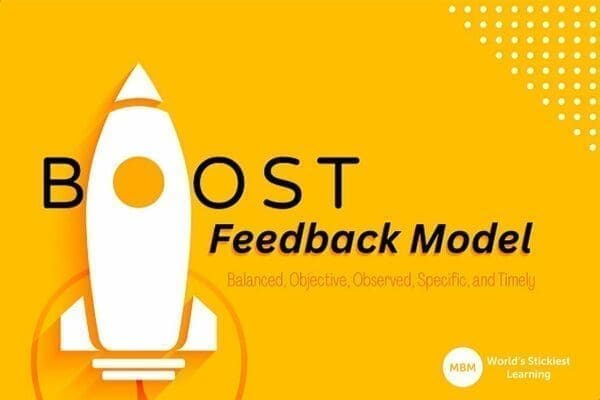Balanced, Objective, Observed, Specific, and Timely Feedback
Have you tried the BOOST feedback model in your organisation? One of the hallmarks of a healthy employer-employee relationship is the willingness of both parties to provide and receive honest, constructive feedback. Although your company may have a formal employee performance management system, this does not preclude the need for informal talks between formal appraisals and meetings.
Informal feedback can be more effective than formal performance reviews in addressing a specific performance issue. Also, it can help in giving the employee time to identify and address the root cause of their underperformance before the situation develops.
The BOOST feedback model explains how to give useful feedback to an individual. It’s a checklist to ensure our comments make sense, are useful, and lead to the desired results. Let’s learn more about the BOOST feedback model and other feedback models.

What is BOOST Feedback Model?
This model’s name accurately conveys the purpose behind it. It intends to provide the receiving team member with a positive boost by concentrating on characteristics that can be “boosted,” including positive and less favourable aspects.
The acronym BOOST makes up the model’s name and has the elements: Balanced, Objective, Observed, Specific, and Timely. The BOOST feedback model approach, in contrast to other feedback methods, expressly asks for both positive and negative feedback to be delivered all at once from its users.
What Does the BOOST Acronym Stand For?
The BOOST feedback model consists of a series of five checks that an individual can perform to verify that any feedback they provide to another individual is constructive. When we talk about constructive feedback, we mean that it is easy to understand, helpful, based on evidence, and has resulted in some change.
The acronym BOOST refers to the characteristics of being balanced, objective, observed, specific, and timely.
Balanced:

The word “balanced” is represented by the letter “B” in the BOOST feedback model. Your feedback should have a healthy balance of positive and constructively critical (developmental) comments.
A lack of drive may result from placing undue emphasis on unfavourable aspects. When giving feedback, it’s important to strike a healthy balance between highlighting the positive and ensuring that the recipient retains the opportunity to grow from the experience.
The use of the sandwich feedback model enhances the balancing of feedback. This strategy, which has been in use for a considerable amount of time, advises that we deliver some positive feedback, followed by some negative feedback, and then one more positive feedback. The feedback is not balanced and thus does NOT function.
However, if we modify it somehow, the sandwich concept can work. It is considerably more beneficial to provide positive feedback first. Then provide negative criticism and finally describe activities to resolve the bad input. We have a positive dialogue about altering it rather than providing further positive comments after the process. The BOOST feedback model helps in balancing the delivery of comments.
Sticky Learning ® is 7 times more effective than 1-day training courses. Plus, you will get a Chain of Evidence proving your Return on Investment. Discover soft skills training that changes behaviours long term.

Here is an Example of Balanced Feedback in the Boost Feedback Model;
“Congratulations on getting to your monthly production targets for May. Nice progress. I did not get your weekly production report for May to ensure frequent reporting of our production. I would like us to keep on improving when it comes to weekly reporting for our production. Keep on hitting the targets.”
Here is an Example of Incorrect Feedback;
“Why are you not submitting your weekly production report for May? In this organisation, we will not keep up with such behavior. Comply with immediate effect.”

Objective:

A few psychological biases can occasionally influence a manager’s decisions in the feedback they get. You should base feedback on the activities and behaviours of the individual. It needs to be more objective and not reliant on the evaluator’s view of a specific individual or their judgment about any particular person. Using the BOOST feedback model can help in achieving objective statements.
Here is an Example of Objective Feedback;
“In our organisation production targets, we usually work towards achieving 85% monthly. In May, you got 75%. This is slightly below our 80% mark. Hoping to see your efforts towards hitting 80% in the subsequent months.”
Here is an Example of Subjective Feedback;
“You did not get the 80% production target in your last month production. Your 75% production for May is way below our organisation’s production. We will not accept any further decline.”
Observed:

“Observed” represents the second O in the BOOST feedback model. The term “observed feedback” indicates that your input corresponds to something you observe instead of receiving feedback from a third party. This indicates that you take responsibility for the feedback and not merely pass it forward.
Suppose the feedback was given to you by a third person, such as a different team member. In that case, you must conduct a thorough investigation to claim ownership of the feedback and present your established proof.
Here is an Example of Observed Feedback in the Boost Feedback Model;
“According to our database, it shows that you are coming to work late and leaving early. This has not hindered you from achieving your monthly production target. To ensure we stick to regulations set out by the organisation, let’s arrive at work and leave on time.”
Here is an Example of Incorrect Feedback;
“Your colleagues are complaining as a result of your poor punctuality. This is completely against our company principles. Consequently, we have noted a decline in your monthly production targets. You must terminate your contract if you don’t follow the stipulated time.”
Specific:

The feedback you provide has to be particular and to the point. Do not provide ambiguous feedback, such as saying that the performance is “not up to the standard.” Instead, you should offer a comprehensive report that breaks down what was anticipated, what has been transpiring, and where they fell short in delivering.
Here is an Example of Specific Feedback in the Boost Feedback Model;
“You ought to submit your weekly production report to the production manager. The manager does not have your report for the second week of May.”
Here is an Example of Incorrect Feedback;
“Why have you not been submitting your reports as required?”
Timely:

It is necessary to provide feedback more regularly than once a year, preferably in a work context. Also, provide this information to the individual receiving the feedback as soon as possible and through the appropriate route.
Imagine for a moment you were going on a journey to some remote location. You must always watch the gasoline meter closely to guarantee you will arrive at your destination and still have plenty of petrol left over till you can locate the next gas station. You need an accurate real-time assessment of how much petrol is still in the vehicle so that you can make appropriate preparations for the remainder of your trip. If you do not possess this knowledge, you risk becoming lost in the middle of nowhere.
This comparison is also applicable to situations that take place in the workplace. It is necessary to provide feedback immediately after accomplishing a certain activity to maintain a high level of performance. At this point, the management and the employee have a complete and thorough understanding of the work’s granular particulars. Therefore, receiving more accurate feedback regarding the task that the staff is completing is feasible.
Here is an Example of Timely Feedback in the Boost Feedback Model;
“Yesterday was the deadline for monthly production report submission. Kindly ensure I have it by tomorrow afternoon.”
Here is Incorrect Feedback;
“Your monthly production reports have not been getting to my desk on time. I don’t understand why you keep getting your things done late.”
Other Feedback Models Apart From the BOOST Feedback Model?
Feedback models are tools that will assist you in providing people with feedback that is succinct, clear, and detailed. As a result, they make it simpler to interact with your team to explore potential areas of improvement and to achieve the objectives of the company and the department.
Businesses frequently use feedback models to assist behavioural changes in the workplace and reinforce employees’ positive actions. Because feedback can be of critical importance in any sector, putting certain techniques into practice can assist several firms in becoming more efficient.
Let’s explore additional types of feedback models other than the BOOST feedback model;
The Sandwich Feedback Model

The sandwich technique is a feedback tool that emphasises achievement and improvement areas, allowing employees to modify certain areas. The tool gets its name from the two bread layers that make sandwiches. In the sandwich feedback model, the conversation opens with some nice comments, and then you point out some areas for improvement. You can conclude with more appreciative remarks after pointing out areas with room for improvement.
The “sandwich method” gets its name from the practice of sandwiching compliments (the “bread”) between suggestions for development (the “toppings”). The primary objective of this feedback strategy is to promote fruitful dialogue.
Employees can benefit from this approach since it encourages them to think more positively during a feedback meeting. The model closely relates to the BOOST feedback model that aims to give balancing, observant, objective, specific, and timely comments.
SBI Feedback Model

The SBI (situation, behaviour, impact) feedback tool provides employees with the ability to reflect on the issue from another perspective, as well as the possibility to propose strategies for improving the situation. The tool presents a straightforward framework that you can follow to deliver insightful, immediate feedback to the recipient.
This is how one might set up feedback using this model:
● Situation
Give a detail of the circumstances surrounding the incident you are referring to.
● Behavior
Describe the particular behaviour and make remarks on the issue.
● Impact
Give examples of how this behaviour affects you, the team, a client, etc.
When you phrase feedback using this technique, you can be sure to clearly describe both the context and the content of your criticism. While this model applies to positive and negative feedback, it does not suggest future action. The BOOST feedback model offers future action hence the difference from the SBI feedback model.
The STAR Feedback Model

The STAR feedback model can assist you in providing pertinent and actionable feedback by considering the following three factors: the circumstance or task, the action, and the results. This form of feedback is an excellent method to express a sequence of events meaningfully to the employee.
The STAR technique functions as follows:
● Situation
Describe the circumstances (or setting) resulting in the issue at hand.
● Task
Focus on the particular task that needs improvement so that you may offer comments.
● Action
Describe the recipient’s actions in the surrounding circumstance.
● Result
Explain the effects of the recipient’s actions.
Pendleton Feedback Model
Pendleton’s feedback methodology motivates employees to participate in the company’s review process. It highlights positive actions, encourages these behaviours, discusses skills to attain them, and examines what the employee may have done differently and useful skills to achieve them.
DESC Feedback Model
The DESC (describe, express, specify, consequences) feedback model is a straightforward yet effective method for reaching out to your employees. It helps staff understand what you want them to do less, more, or differently to enhance their performance and productivity. Also, this technique is less conversational than usual, yet it might pinpoint the issue and provide prompt impetus to alter course.
Let’s examine the DESC feedback model in detail;
● Describe
You begin by outlining the circumstance, as is typical of most feedback tools on this page.
● Express
Discuss the effects you, your team, or the entire organisation face due to the emerging circumstances.
● Specify
Now thoroughly explain the recipient’s behaviour change and detail a list of the appropriate actions.
● Consequences
Finally, demonstrate to the receiver how the actions you are suggesting will affect you, your team, or the company in the future.
The CEDAR Feedback Model

The CEDAR feedback model differs from the BOOST feedback model in that it includes a review process at the end to ensure clear alignment and comprehension. Also, it includes a stage in which you ask the recipient for their opinion on handling the circumstance.
The five steps of the CEDAR feedback model are as follows:
● Context
Prepare a setting for receiving comments. Verify your employee’s comprehension of the value of comments on their performance. If workers are given context for how their comments fit into their overall performance, they are likelier to take them to heart.
● Examples
Clearly and precisely describe the performance you have been witnessing. Don’t wait for praises before you take the initiative to recognise accomplishments. However, you should allow the worker to choose the trickier examples.
● Diagnosis
Avoid making assumptions and encourage workers to reflect on what brought them to this point. Open-ended inquiries such as “What brought you to where you are right now?” can help you gain this understanding.
● Action
Make plans and objectives using the information you have thus far. Helping the worker zero in on these behaviours and objectives will keep the mood of cooperation high.
● Review
Get the worker on a review schedule and stick to it. Together, you’ll be able to see where any issues arise or successes are made along the way to your goals.
Conclusion
BOOST feedback model does a great job as an informal feedback model in fostering a culture of constant feedback and boosting employee engagement. Managers and staff members benefit from this process since it allows them to identify problem areas and the underlying causes. Once documented formally, it may impact an employee’s performance review and subsequent pay.
Follow us on Linkedin to never miss an article.




